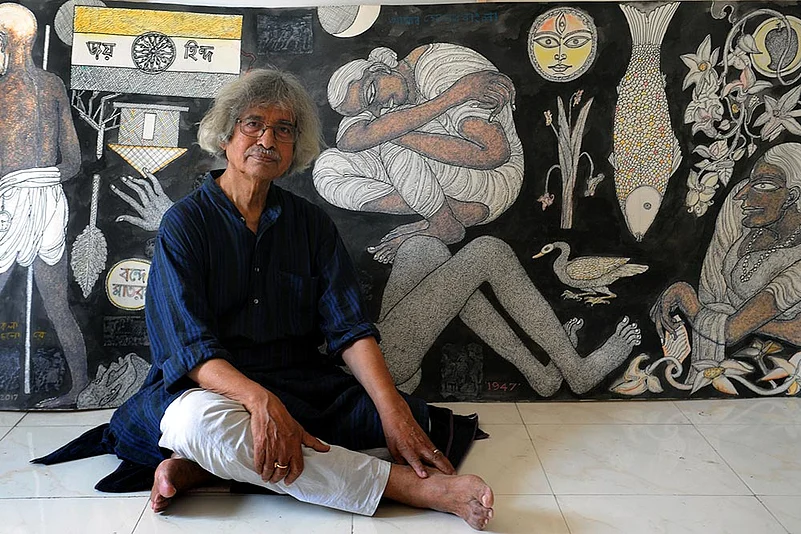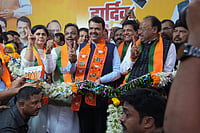The interview starts on a rainy evening, with the thrum of cars in the background, as call after call is merged—an interviewer speaks to an anxious PR person, who in turn reaches out to his calmer colleague further down the line to Shantiniketan—with silence. Finally, the interviewer asks, in a quivering voice, “Jogenda, can you hear me?”
At the other end of the much-media-ted line is Jogen Chowdhury, a master of Indian contemporary art. An editor terms him “the last of the greats”; curator Uma Nair calls him a “modern master”. Anupa Mehta, curator for Calcutta’s Emami Art Gallery, says that he is an artist whose range and style creates an inimitable vocabulary. Chowdhury’s three-month-long solo exhibition, a select retrospective titled Reverie And Reality, curated by Ranjit Hoskote, opened in Emami Art on September 20.
Jogenda is 80. His voice holds memories of his oeuvre, from which nearly 200 will be displayed. “Ranjit has selected the paintings and I gave my notes to him,” Chowdhury says.
Analysing his own work with a critical, objective eye in a way only a deeply self-referential artist can, Chowdhury says his paintings can be organised in several different periods, as identified with the prevalence of particular motifs, such as the well-known ‘Ganesha’ period. This exhibition, says Hoskote, aims to revisit Chowdhury’s extensive oeuvre—“an experimental way of viewing”.
Seen chronologically, Chowdhury’s stages of evolution as an artist—of lines, colour palette, texture and artistic vision—are clearly delineated. The realism of figurative canvases, and the fresh, translucent, almost watery quality to the many colours he uses during his time at the Government College; in Paris, he is preoccupied with the human figure, drawing stark, pensive, thin-lined portraits of Europeans; after his return, working in Madras, there is an immediate shift—the colours become earthier and more solid and opaque, the subjects change from realistic portraits to surrealistic landscapes of animals and flowers. It is possible to see today’s Jogen Chowdhury beginning to take shape, with the bulbous forms of animals to the beginning of the cross-hatching technique that have now become his trademarks.

Study of a girl, 1962, pencil on paper.
“Art education at college was academic; emphasis was on technique with still life, nature studies, portraits and life studies,” he recalls, “There was little scope for imagination in perspective and only somewhat in composition. I would see around me paintings by the Tagores, both Rabindranath and Abanindranath, and I’d see no resemblance between their work and mine.”
This preference for the abstract over the photo-realistic, and concept and metaphor over physically perceived reality, propelled Chowdhury to exploring other ways of expression. As a student, his interest lay in how the ‘abstract’ could be instilled within the ‘real’; he wanted to take the building blocks of art and meld them into a unique ‘representative form’. Much of his artwork has been infused with Tagore’s idea of beauty in the non-beautiful (rooper modhye oroop), a need to imbue a sense of eternity into his creations.
This idea led Chowdhury to develop signature techniques, like cross-hatching, that attracted him the more he employed it, indulging his love of creating characters in his paintings, adding a new layer of complexity in his human figures—disproportionately distorted, with long torsos, loose limbs and elongated, flattened faces. The distortion of any shape inevitably results in the creation of a new form, points out Chowdhury, much as a word can be elongated in a song to give it new significance: “The figure is redistributed totally, from the pose to the limbs, to the expression. God created both elephant and giraffe. He created animals with different lines, in different shapes. Has anyone ever asked why? Then why ask us?”
It wasn’t just the desire to express the familiar in unfamiliar ways that shaped Chowdhury’s artistic credo. Social realities influenced him deeply. “My family came from East Bengal, during Partition. We didn’t know where we would stay.... There was a huge crisis of food, education and employment, and we, the refugees, felt it the hardest,” the artist recalls. “The crisis spurred the Leftist movement in my youth, and in 1965, when I joined the Art College, both the political situation and our personal lives were in absolute turmoil.”
In the Calcutta of the ’60s—seething in miasmic distress—he started painting with black ink to create multiple layers of anguish. It was, perhaps, natural that a movement away from the city, to a different form of institutional tutelage in Paris, would have come as a welcome distraction. “I worked recklessly in Europe,” he says, “And it wasn’t enough.”
At first at a loss for subjects, Chowdhury settled on absorbing the enormous historical and cultural legacy of Europe. Viewing the European painters, he was struck by their sense of vocation—“whole-timers”. “We, in India, we had jobs!” he exclaims with youthful incredulity. “None of us could have afforded to just paint. We all painted in the evenings or during breaks!”
He recalls asking himself if he should follow the Europeans, and whether his work should encompass European realities too. He decided that his art would reflect his unique understanding of his own reality. “Indian society is complex and rich and provides me with enough material,” he remembers concluding. Chowdhury succeeded in that endeavour. “Jogenda is one of the few who can create with a very deep understanding of Western grammar but with elements and subjects firmly rooted in the Indian tradition,” Nair points out.
On his return, Chowdhury moved to Madras with a job in the Handloom Board. The city, with its then-quiet environs, calmed him. “I had the time, in Madras, to go on long walks and observe nature, the flowers, the birds, the sky,” he says. “I wrote a nearly 100-page manifesto in Chennai, detailing where I felt my work should be headed. That was the first major change.”
He did a lot of work on paper, from paintings to drawings, drawing motifs and patterns from nature—flowers, fish, fruits, insects—in a sort of surrealist dreamworld bearing little resemblance to his realist works in Europe. “In Madras, I began to work more with dream landscapes. I was there for four years. I liked that city very much,” he says.
Chowdhury’s remarkable ability to sift what he wanted from his surroundings sharpened his observation, leading him to his subjects.

It also made him into an astute political commentator armed with sharp wit who would create political satire such as Tiger in Moonlit Night—a landscape in which a tiger attacks a prone man—seen as a mordant reaction to the Emergency. During those years, he was at the Rashtrapati Bhavan as the curator of its art gallery. “While I was there, I observed the politicians at work—their dress, their speech, their walk, their mannerisms,” he recalls. “It was impossible not to caricature them.”
Though he chafed under the Emergency, he remembers his association with Indira Gandhi with fondness, describing her as ‘charismatic’. “She understood, for example, the value of using the right colour of frame—silver—to accentuate the tones of a painting—mainly blue—in a room painted grey.... She had a sensibility about art that is rare and, I think, was a result of her education at Shantiniketan.”
Chowdhury himself has been a long-time resident of Shantiniketan and teaching at Viswa Bharati’s Kala Bhavan since 1987. “Art cannot be taught, really,” he says. “I can teach a person how to draw a line or colour in, but I cannot teach them how to overcome themselves.” Chowdhury points out that we need more institutions to uncover more talents: “If Ramkinkar Baij had remained in his village, he would not have been Ramkinkar Baij.”
Chowdhury emphasises that while the narrative aspects of artists from Kala Bhavan have not influenced his work, their originality and their manner of ‘building up’ a work of art have left a deep impress, including, the work of his beloved Rabindranath. “The fierce physicality of Ramkinkar’s sculptures impressed me immediately,” he says. “There is a similarity with Picasso somewhere. Benode (Behari Mukherjee) da’s work taught me about fluidity—how to draw a line, how to give a brushstroke. And the fun of Nandalal (Bose)’s work is how he builds a form, from the solidity of a tree to the languidness of a creeper.”
Even at his age, Chowdhury works incessantly. Nair, who had spent several days with Chowdhury in Shantiniketan, says he constantly doodles: “There was never a moment in which his hands were still. He was constantly drawing, and all he drew—even a random line on a blank page, the way he loops them—was so fluid, so beautiful.” Chowdhury refers to these as haikus—smaller, quicker works, like those ephemeral, yet immaculate and astute, Japanese fragments. Some are at the exhibition: a sort of inside glimpse into the artist’s mind, as Hoskote puts it.
The 152-page catalogue created by Nair—Abahoman: Flowing Life—is termed by her as ‘a piece of history’: “The days I spent watching him work there cemented the idea in my mind that he is one of the greatest ambassadors of the Bengal School—a contemporary modernist.” Mehta agrees: “He is a spokesperson for the entirety of Bengal.”
It’s easy to forget, when we talk about Chowdhury’s immense artistic vision, that art to him primarily seems to be a form of play. The phrase that he uses most often when talking about his work is etatey amar moja legechhey (“this is what I found to be fun”). He uses it when mentioning his artistic influences; speaking about the conditions that inspired him to create or while discussing the evolution of his technique.
Perhaps it is this delight that he takes in expression that makes his paintings so vividly alive, so impressive in their non-beauty. In Yeats’s introduction to the English translation of Gitanjali, he quotes Dwijendranath Maitra describing Tagore thus: “He is the first among our saints who has not refused to live, but has spoken out of Life itself....” The same could, veritably, be said of Jogen Chowdhury.
(Reverie and Reality, curated by Ranjit Hoskote, opened at Emami Art, Calcutta, on September 20)
















